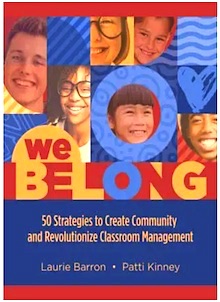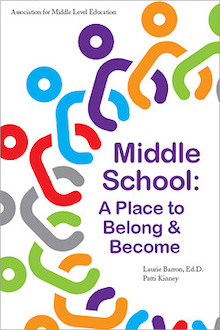Kids Need Us to Keep These 25 Promises
By Laurie Barron and Patti Kinney
From childhood promises we made with a pinky swear – to more serious marriage or religious vows – we‘ve all made (and sometimes broken) an uncountable number of promises in our lifetime.
Just what is a promise? We define it as an assurance that one will do a particular thing. So what kind of promises do we need to make (and keep) so that our students will truly believe that they belong in our classrooms and will be safe and cared for there?
In our book We Belong we shared 25 promises we feel have the greatest impact on promoting belonging and creating a middle grades school or classroom community that elicits positive classroom behavior.
Here we’ve categorized those promises into four groups: Relationships, Safety, Consistency, and Instruction. While most can fit into more than one category, we think this is an easy way to approach the daunting task of keeping 25 commitments to those we teach.
Promises that Promote Relationships
► Learn constantly about students as a group and as individuals.
► Be available to each student and all students.
► Be an obvious and passionate advocate for each student.
► Let students see evidence that I am helping every one of them belong.
► Be agreeable, be patient, smile, encourage constantly, and speak kindly.
► Treat all students with respect at all times.
► Make some positive contact with each student every day.
► Laugh, embrace and include humor, and show that I enjoy being with students.
► Be honest, direct, and real.
There is no question that relationships are important. We both love the James Comer quote, “No significant learning occurs without a significant relationship.” Building those significant relationships with students requires three things – getting to know your students, letting your students get to know you, and ensuring your students get to know each other.
Most teachers make efforts to know their students at the beginning of the year but sometimes forget to revisit that knowledge throughout the year to stay aware of issues that students may be facing. One way to reinforce mid-year connections with your students is with a simple feedback survey: What should I keep doing? What should I start doing? What should I stop doing? What else should I know about you?
You know them; do they know you? Ask yourself, what do I share about my life with my students? Do they know why you became a teacher, what you’re interested in learning about, what your hobbies are, what you were like at their age, and so forth?
Share a failure or two you experienced. Ask their advice when appropriate – what should you name your new pet, what kind of new car should you get, where’s a good place to eat?
The third prong is to be sure students know each other. One strategy is to pair students and ask them to each share two pieces of information about themselves; group three pairs together, and have each partner introduce his or her original partner to the group by telling the two pieces of information learned. Repeat with different groups of three partners and let the introductions continue.
Promises that Provide Safety
► Keep students safe from taunting, derision, exclusion, and bullying of any kind.
► Give students stress-free, embarrassment-free ways to communicate with me.
► Never yell, threaten, manipulate, shame, ridicule, label, judge, or demean.
► Make my nonverbal messages as caring and nonthreatening as my words.
► Give messages of equal worth for all students, showing no biases or favoritism.
► Confront students’ misbehavior in private, never disciplining anyone in front of others.
No matter the age, but particularly for our youth, feeling valued, important, and safe matters.
Physical safety must be a top priority. If your school hasn’t already, be sure to conduct a school safety checkup on a regular basis, at least annually. Your check up should start with the “feel” of the building and classroom. Do all places feel welcoming? Are adults actively supervising students? Do students have opportunities to share concerns? Are families welcomed in the school?
Emotional safety is a top priority as well. Ask yourself how you and your school help students define and demonstrate values that help everyone feel safe. Are there strategies in place to ensure that everyone is seen and heard? Are appropriate behaviors discussed, modeled, and upheld? Are students acquiring and practicing social-emotional skills to help them cope with feelings of insecurity?
Ensuring the physical and emotional safety of students (and staff, including yourself) can sometimes feel overwhelming. Understanding adverse childhood experiences (ACEs) and implementing trauma-informed practices are two ways to help improve the environment, not just for those experiencing these challenges but also for other students who share the environment. Also remember that providing a safe and healthy environment is a team effort. Often we need to collaborate with others when our efforts are not successful or there are more serious issues such as weapons, drugs, or harassment.
Promises that Practice Consistency
► Set clear expectations for students to treat each other respectfully; teach them explicitly what that means and hold them to expectations equitably.
► Provide a structured (not rigid), predictable, and safe environment.
► Be fair, but realize that being “fair” may not always be equal for each student.
► Be trustworthy, keep my word and do what I say I will do.
► Set procedures and expectations and follow through on them – consistently.
We all know the importance of being consistent, following through, and doing what we say. And every year we promise ourselves we’ll be consistent . . . but then that promise seems to melt away, and we can end up struggling with classroom management.
A few thoughts to help you be more consistent:
- First, think of it as a student right, not your choice! You are consistent because you care about your students and know they deserve your best.
- Second, don’t establish a hard-and-fast rule or protocol that you know you will not be able to consistently enforce, follow through on, or hold students accountable for.
- Third, remember consistency does not mean rigidity. Treating students equitably does not mean they must be treated the same way. Consider what you know about the student and deal with the situation in the way that meets the student’s needs, the class needs, and your needs. For example, you may always give consequences for a particular misbehavior, but it doesn’t have to be the same consequence for every student.
Promises that Assure Quality Instruction
► Honor each student’s unique qualities, abilities, and interests.
► Show passion for the subject and concepts I teach and show students I enjoy teaching them.
► Set high learning expectations and help them reach them; help them over individual learning hurdles, and let all students know I believe they can succeed.
► Ask for and listen to students’ opinions, ideas, and evaluations; act on them.
► Make learning fun.
When it comes to maximizing a student’s potential, there are few replacements for high quality, engaging instruction in a safe and supportive environment. Effective classroom management depends on effective instruction.
Remember to set the instructional tone early, beginning with the first day of school. Make sure that first day is full of engaging, cooperative opportunities to learn together. (Nothing is more boring and less engaging than returning from summer break to a full day of teachers reading rules to students from the handbook or syllabus.)

Promise Yourself!
Make a promise to yourself that you will review these promises on a regular basis, and decide if there are ones that need work.
And, yes, we know teaching is hard, and it’s been especially difficult the past several years. So we have decided to add a most important twenty-sixth promise to this list: Take care of yourself!
Take a deep breath, squeeze a stress ball, have a glass of water, eat some protein (or chocolate!), go outside for a few minutes, listen to some music, read a thank you note, pursue a hobby, exercise, or relax with a book or television show.
“Taking care of yourself doesn’t mean me first, it means me too” (LR Knost).
More help: ASCD has graciously made many of the resources such as surveys, checklists, and handouts discussed in our book We Belong available as free reproducible downloadables.
Education leaders Laurie Barron and Patti Kinney are co-authors of We Belong: 50 Strategies to Create Community and Revolutionize Classroom Management (ASCD, 2021) and also Middle School: A Place to Belong and Become (2018, AMLE). Read an ASCD interview with Laurie and Patti here: The Power of Being.








































Laurie and Patti, this is spot on! Your advice is succinct, specific, and so true! Thanks for sharing the wonderful insights from your amazing book! Wouldn’t it be great if all us educators could keep the promises to kids? Thanks for a great reminder.
I just read your book as part of a class I was taking. I am a pre-k teaching assistant and I am so excited for the school year to start. There were so many great ideas. There were times when I was answering a question, speaking on something in the book and I would think of a new idea. Your book inspired me. Do you do professional developments? If not you should look in to it. This is definitely a book that I intend to share with my colleagues. I also intend to keep the book in my classroom, so I can take your advice and review these promises on a regular basis. Especially when I am stressed and lacking patience. Thank you for the great information. I hope to be a better educator and a better faculty member.
Laurie and Patti,
I just finished a course and your book, and let me begin by whole heartedly saying “Thank you!”.
This book has touched on so many aspects that, we as teachers take for granted. Making sure our students feel a sense of belonging is something that we, as educators always strive for. Unfortunately, the day to day mayhem sometimes makes us forget how important it is to revisit those times when we check in with students, when we tell a funny story about our own lives, or when we give students opportunities to share their experiences and expertise.
So once again, thank you for reminding us why we chose to join this profession- to ensure every child is and feels valued.